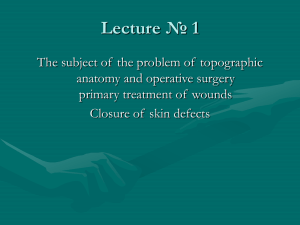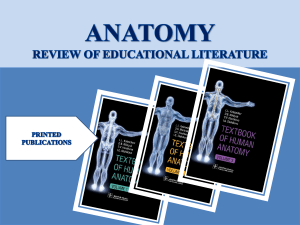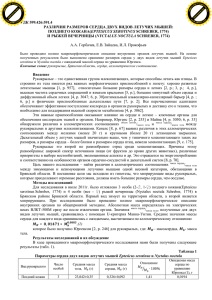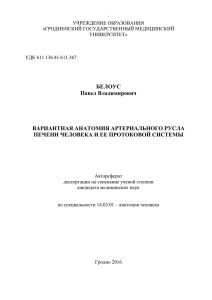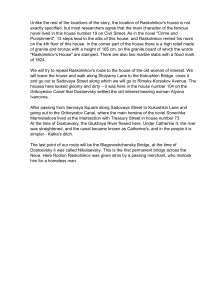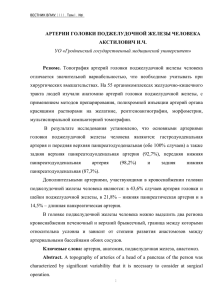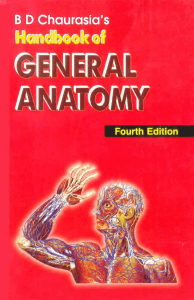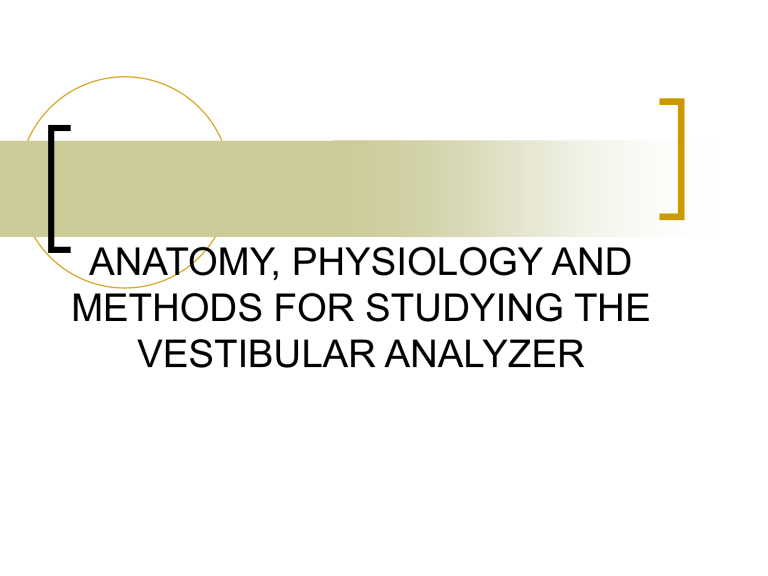
ANATOMY, PHYSIOLOGY AND METHODS FOR STUDYING THE VESTIBULAR ANALYZER Topographic labyrinth anatomy 1 2 3 4 5 6 1- vestibular cochlear nerve 2- cochlea 3- the threshold 4- anterior (frontal) semi-circular canal 5- posterior (sagittal) semicircular canal 6-lateral (horizontal) semicircular canal clinical anatomy of the vestibule and semicircular canals ◼ ◼ ◼ ◼ ◼ ◼ Inner ear (auris interna) - the labyrinth is subdivided: I. - snail (cochlea), - vestibule (vestibulum), - the system of semicircular canals (canales semicirculares). II. - bone labyrinth - membranouse labyrinth Bone labyrinth 4 Membranouse labyrinth 5 clinical anatomy of the vestibule and semicircular canals ◼ ◼ ◼ ◼ ◼ ◼ ◼ ◼ ◼ ◼ ◼ ◼ ◼ ◼ ◼ ◼ ◼ ◼ ◼ 1-snail 2-vestibule 3-ampoule of the anterior semicircular canal (PC) 4-ampoule of lateral PC 5-lateral PC 6-back PC 7-front PC 8-elliptical bag 9-otoliths 10-gelatinous mass 11-stereocilia 12-hair cells 13-vestibular cochlear nerve 14 ampoule comb 15 ampoule sulcus 16-transition zone 17-neuroepithelium 18-hair cells 19-cupule ampoule clinical anatomy of the vestibule and semicircular canals clinical anatomy of the vestibule and semicircular canals ◼ Structure of the otolith apparatus (diagram) clinical anatomy of the vestibule and semicircular canals clinical anatomy of the vestibule and semicircular canals clinical anatomy of the vestibule and semicircular canals ◼ the structure of the ampullar part of the membranous semicircular canals (scheme) The physiology of the internal ear Angular acceleration causes endolymph current in the semicircular canals and the emergence of a nerve impulse. Blood supply to the labyrinth The function of the vestibular analyzer: ◼ ◼ ◼ ◼ Center of gravity stabilization Ensuring precise movement coordination Support for a given body position Analysis, comprehension of the position and movement of the body Ewald's laws (1892): ◼ ◼ ◼ Reactions (nystagmus, tonic reactions) arise from the semicircular canal, which is in the plane of rotation; The direction of movement of the endolymph corresponds to the direction of the slow component of nystagmus and tonic reactions; The movement of the endolymph towards the ampulla causes a stronger reaction than the movement of the endolymph towards the smooth end (in the horizontal semicircular canal. Types of vestibular reactions ◼ ◼ ◼ ◼ ◼ Vestibulosomatic Oculomotor Vestibulo-vegetative Vestibulocerebellar vestibulocortical Spontaneous vestibular nystagmus(SNy) ◼ involuntary rhythmic, biphasic, oscillatory movement of the eyeballs. ◼ the direction of nystagmus is determined by its rapid component. 5 main characteristics of vestibular nystagmus: ◼ ◼ ◼ ◼ ◼ 1. plane 2.direction 3.Ratio of fast and slow components 4.intensity 5.amplitude Study of statics and coordination: ◼ ◼ ◼ ◼ ◼ ◼ 1. test of outstretched hands. 2. finger-nose test. 3.finger-finger test 4. test of stability in the Romberg pose. 5. study of straight gait. 6. study of the flank gait. Caloric samples: ◼ When calorizing with "cold" water, nystagmus is directed towards the ear under study, with irritation with "warm" water - in the opposite direction. The subject's arms are deflected towards the slow component of the caloric nystagmus. Rotational tests ◼ designed to assess the function of the vestibular system when exposed to angular accelerations
